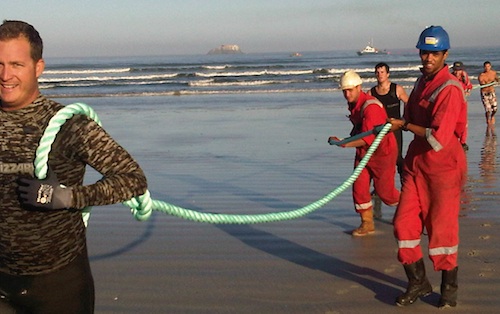
Consumers can look forward to even cheaper broadband prices, with many new undersea cables set to come online within the next 18 months. It is unclear how much of a decrease is likely, but talk in the industry is of a 10% to 20% drop in local prices, which are regarded as being among the highest in the world.
The Seacom cable may have increased SA’s undersea capacity by 380% since it was launched in 2009, but several new cables are set to increase broadband capacity by a further 360% — more than the total of all undersea cable systems serving the country.
The West Africa Cable System, or Wacs, a submarine communications cable linking SA to the UK along the west coast, landed in Yzerfontein in the Western Cape in April last year and is expected to come online in the second quarter of 2012.
The Africa Coast to Europe cable, or Ace, which will run between France and SA, along the west coast of Africa, will be completed in late 2012 and will be of a similar size to Wacs.
The South Atlantic Express cable, or SAex, which connects SA and Angola with Brazil, is expected to be operational by June 2013 and will provide 12,8Tbit/s of capacity, which is 10 times the capacity of the Seacom cable and two-and-a-half times the capacity of Wacs and Ace.
What now for pricing?
It is clear South Africans will be swimming in international broadband capacity, but what is the likely effect on pricing? Some industry pundits reckon the expected drop in broadband prices might not be significant. But many of these are the same players who said the introduction of Seacom would have no major effect on pricing — and they were wrong.
However, it is important to acknowledge that when Seacom launched it was challenging the status quo at a time when Telkom had a monopoly on undersea cable capacity and could therefore afford to keep prices artificially high.
But analysts — like Steve Song, the founder of Village Telco — were more optimistic. “We are going to see another tectonic shift in pricing. I think we will see the same magnitude in price decreases that we saw with Seacom,” says Song.
He believes the price drops will spur domestic competition as was experienced when Seacom came on stream. However, he is quick to say the lack of backhaul capacity to transfer bandwidth within SA will limit the impact of the new cables until these capacity issues are addressed.
“The arrival of Seacom was the beginning of the big change and Wacs has tons of capacity,” says Song, adding that the system will provide another big price drop.
Alison Gillwald, executive director of Research ICT Africa, says in theory the increase in undersea capacity should mean that prices would come down purely on a supply-and-demand basis, but this assumed an open and perfect market, which SA does not have.
“We have serious bottlenecks in SA,” she says in reference to issues such as unbundling the local loop, increasing national backhaul to carry the data within the country and access to spectrum to roll out wireless services. These have the potential to limit the real benefits of the new undersea cables.
The Seacom cable shook things up in the market. Seacom says on its website that a 700% increase in international bandwidth supply occurred in SA following the launch of its undersea cable.
The PricewaterhouseCoopers’ SA entertainment and media outlook 2011–2015 report says Internet traffic doubled in 2010. “In the next few years, SA consumers can expect a decrease in broadband Internet prices, higher speeds and a more stable service.”
The report says broadband prices are still too high and predicts total Internet access spending will increase from R12bn in 2010 to R35,7bn in 2015. It also forecasts that fixed-line broadband subscriptions will increase to 2,85m in 2015 from 600 000 in 2010. More undersea cables will give consumers a much-needed boost and relief from high costs. — Lloyd Gedye, Mail & Guardian
- Visit the Mail & Guardian Online, the smart news source
- Subscribe to our free daily newsletter
- Follow us on Twitter or on Google+ or on Facebook
- Visit our sister website, SportsCentral (still in beta)




